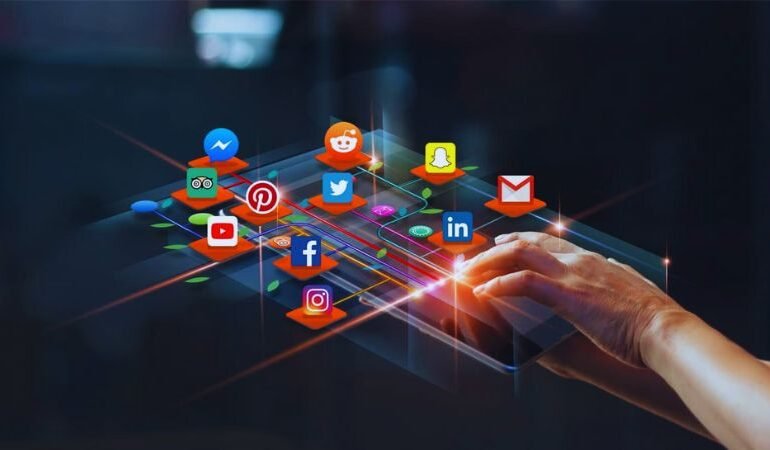The Evolution of Digital Marketing: From Banner Ads to AI-Powered Campaigns

Digital marketing has undergone a dramatic transformation over the past two decades. What began as simple banner ads and email newsletters has evolved into a sophisticated ecosystem powered by artificial intelligence (AI) and big data. This article traces the evolution of digital marketing, highlighting key milestones, the rise of social media, content marketing, and the cutting-edge innovations shaping the future of the industry.
The Early Days: Banner Ads and Basic SEO
In the mid-1990s, digital marketing was in its infancy. The first-ever online banner ad appeared in 1994, marking the beginning of a new era in advertising. These early ads were simple, static images that appeared on websites, inviting users to click through to the advertiser’s page. The click-through rate (CTR) for these ads was significantly higher than what we see today, as users were still curious about this new form of advertising.
Search Engine Optimization (SEO) also began to take shape during this period. As websites proliferated, the need to organize and rank them became apparent. Early SEO practices were rudimentary, focusing on keyword stuffing and meta tags. However, as search engines like Google refined their algorithms, SEO strategies became more sophisticated, emphasizing quality content, backlinks, and user experience.
The Rise of Social Media: A New Marketing Frontier
The early 2000s saw the rise of social media platforms, which would forever change the landscape of digital marketing. Platforms like MySpace, Facebook, and Twitter offered new opportunities for brands to engage with their audiences directly.
Social media allowed for a more interactive form of marketing. Instead of merely broadcasting messages, brands could now engage in two-way conversations with consumers. This shift led to the development of social media marketing strategies focused on building relationships, fostering community, and creating shareable content.
Facebook, in particular, became a dominant force in digital marketing. The platform’s ability to target ads based on user demographics, interests, and behaviors revolutionized online advertising. Brands could now reach highly specific audiences with tailored messages, increasing the effectiveness of their campaigns.
Content Marketing: Engaging Audiences with Valuable Content
As social media grew, so did the importance of content marketing. Brands realized that to stand out in a crowded digital space, they needed to provide value to their audiences. This led to the rise of content marketing, which focuses on creating and distributing valuable, relevant, and consistent content to attract and retain a clearly defined audience.
Blogs, videos, infographics, and eBooks became essential tools for brands looking to engage with their customers. Content marketing allowed brands to establish themselves as thought leaders, build trust with their audiences, and drive organic traffic to their websites.
The mantra “content is king” became popular during this time, emphasizing the importance of high-quality content in digital marketing strategies. Companies like HubSpot and Moz led the charge, offering insights and tools to help businesses succeed in the content-driven world of digital marketing.
The Mobile Revolution: Marketing on the Go
The proliferation of smartphones in the late 2000s added a new dimension to digital marketing. Mobile marketing emerged as a critical component of marketing strategies, with brands needing to optimize their content and campaigns for smaller screens.
Mobile apps, SMS marketing, and location-based services offered new ways to engage with consumers. The rise of mobile also led to the popularity of responsive web design, ensuring that websites provided a seamless experience across devices.
The introduction of mobile payment systems like Apple Pay and Google Wallet further expanded the possibilities for mobile marketing. Brands could now offer targeted promotions and deals based on a user’s location or previous purchase history, making marketing more personalized and immediate.
The Era of Big Data: Personalization and Targeting
As digital marketing matured, the amount of data generated by online interactions grew exponentially. This wealth of data, often referred to as “big data,” opened up new opportunities for marketers to understand and predict consumer behavior.
Big data allowed for a level of personalization that was previously unimaginable. By analyzing data from various sources—such as social media, website analytics, and purchase history—marketers could create highly targeted campaigns tailored to individual preferences.
This era also saw the rise of programmatic advertising, where automated systems use data to buy and place ads in real time. Programmatic advertising streamlines the ad-buying process, making it more efficient and allowing for greater precision in targeting.
However, the use of big data also raised concerns about privacy and data security. The introduction of regulations like the General Data Protection Regulation (GDPR) in Europe highlighted the need for marketers to balance personalization with respect for consumer privacy.
AI-Powered Marketing: The Future is Now
The latest frontier in digital marketing is the integration of artificial intelligence (AI). AI is transforming every aspect of marketing, from content creation to customer service.
One of the most significant applications of AI in marketing is in customer segmentation and personalization. AI algorithms can analyze vast amounts of data to identify patterns and predict customer behavior. This allows marketers to create hyper-personalized experiences for their customers, improving engagement and conversion rates.
AI-powered chatbots are another innovation changing the way brands interact with customers. These chatbots can handle customer inquiries 24/7, providing instant responses and improving the overall customer experience.
Content creation is also being revolutionized by AI. Tools like GPT-3 can generate human-like text, enabling brands to produce content at scale. While AI-generated content is still in its early stages, it holds the potential to significantly reduce the time and cost associated with content production.
AI is also enhancing the effectiveness of digital advertising. Machine learning algorithms can optimize ad placements in real-time, ensuring that ads are shown to the most relevant audiences. This results in higher ROI and more efficient use of advertising budgets.
The Future of Digital Marketing: Emerging Trends
As we look to the future, several trends are poised to shape the next phase of digital marketing.
- Voice Search and Smart Speakers: With the rise of devices like Amazon Echo and Google Home, voice search is becoming increasingly popular. Marketers will need to optimize their content for voice search, focusing on natural language and conversational keywords.
- Video Marketing: Video content continues to dominate online platforms. The popularity of short-form video content, such as TikTok and Instagram Reels, presents new opportunities for brands to engage with younger audiences.
- Augmented Reality (AR) and Virtual Reality (VR): AR and VR technologies are offering new ways for brands to create immersive experiences. From virtual try-ons to interactive ads, these technologies are set to redefine how consumers interact with brands.
- Sustainability and Ethical Marketing: As consumers become more conscious of environmental and social issues, brands will need to demonstrate their commitment to sustainability and ethical practices. Transparency and authenticity will be key to building trust with these consumers.
- Blockchain Technology: Blockchain has the potential to revolutionize digital marketing by providing greater transparency and security in advertising transactions. It could also enable new forms of loyalty programs and digital identity verification.
Conclusion
The evolution of digital marketing from simple banner ads to AI-powered campaigns reflects the rapid pace of technological advancement. As new technologies emerge, marketers must continually adapt to stay ahead of the curve. Understanding the history of digital marketing provides valuable insights into its future, emphasizing the need for innovation, personalization, and a deep understanding of consumer behavior. As we move into the next phase of digital marketing, the key to success will be the ability to harness new technologies while maintaining a focus on delivering value to the consumer.






